Bus Models for Japan
07 April 2013 23:48 Filed in: Other Models
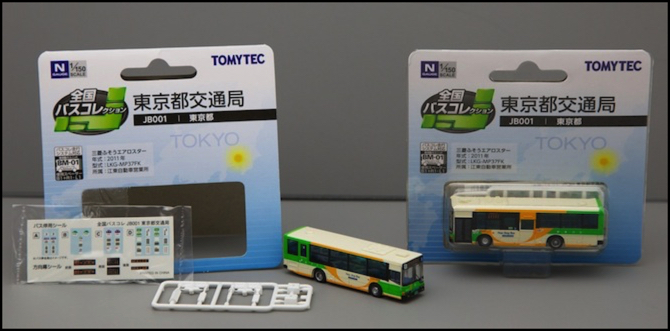
Jerry’s recent post on Quintopia about cars and the arrival of my order for four N-scale Tomytec bus models have me thinking about road vehicles.
One of the hardest parts of modeling a contemporary model railroad is the lack of contemporary road vehicles. By far the majority of what is available seem to be things not seen on roadways for half a century. And an urban railroad needs a LOT of model vehicles to look even slightly realistic. And they can’t all look exactly alike either.
As Jerry noted, Tomytec’s collections of cars, trucks, and busses (links are to Japanese pages) are a very good way of acquiring fairly detailed models in bulk at reasonable costs. A typical car collection bought from Japan runs US$67 before shipping and contains twelve boxes, each containing (typically) two vehicles. Even with shipping, that’s likely less than $5 per vehicle. Not as cheap as the low-quality Chinese models available off Ebay, which are suitable for filling in back streets, parking garages, and other places where the car is more glimpsed than seen. But a good price for a detailed model, and about a third of what European models go for.
Shipping from Japan isn’t cheap. I use EMS (express mail), and shipping my order of four busses cost me $15, about 50% of the cost of the busses themselves. But I’m impatient, and EMS gets the package to me in about five days. If you can wait weeks (or sometimes months), shipping SAL (standby air) will be a lot cheaper for small, lightweight, models like these. But it’s still going to be a significant part of the total cost. If you want to order these, see the websites of the Japan-based hobby stores listed on my Suppliers page for more specific information.
More than Cars
City streets contain more than just cars. And when modeling a specific prototype, this can require a vehicle specific to a town or region, or at least having those will help set the scene for people who are familiar with the area. And few things are more distinctive than a bus. It’s large, typically has a color-scheme for a specific regional transit company, and is fairly common on major urban roads. And train stations, particularly in Japan, are multi-modal facilities with taxi stands and bus parks adjacent to the station entrance, often with several busses waiting at a time at larger stations.
My Urban Station Scene has long been planned to have a bus/taxi terminal located under the viaduct station. I’d like to have it more visible, but there’s just no room elsewhere near the station. But regardless of location, it needs local busses to look good, and at first I couldn’t find ANY contemporary Tōkyō-area bus models.
The Tomytec Bus Collections by the way, aren’t as good a way to get models as the Car Collections, because for US$85 you get 12 busses ($7 each before shipping), but they are a mix of ones from different regions. The price is nice if you don’t care about appearances, but that’s a problem for me. As with car collections, they’ll slip a “special” model in some sets, which means that if the collection only includes one bus you want, you might not even get that one, and these things are sold blind so you don’t know what you’re getting until you open the box (there are stores in Japan that sell opened single-boxes, at a premium, but I’m not aware of any that do international sales via the web).
The other thing to be aware of with all of the “collections” is that they often sell out promptly, and while most will eventually be re-run, this could be months if not years later. This is one of those models where you have to watch the reservations lists on one of the Japanese sites that does advance reservations, and buy when they are announced, not months later when they ship. You may find something in stock later, but not always the one you want, particularly if it’s an uncommon model.
I did actually buy one of these, Set 11, as it was the only way to get another Toei bus at the time. This was a 1996-era Nissan 96MC and I got exactly one of them, plus eleven other busses none of which appear to be for the Tōkyō area, although it’s hard to be certain as none of the info is in English. The paint scheme on the Toei bus is likely a bit dated, but “close enough” for my kind of modeling. I’ll likely find uses for the others in back-of-scene locations, and on my Urban Tram Layout, but I’m not likely to buy more this way. With these sets, like the Car collections, all you get is the bus, with markings already applied.
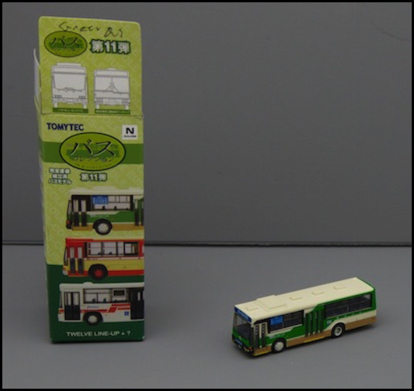
Toei bus #121 from Bus Collection Vol. 11 - Nissan 96MC
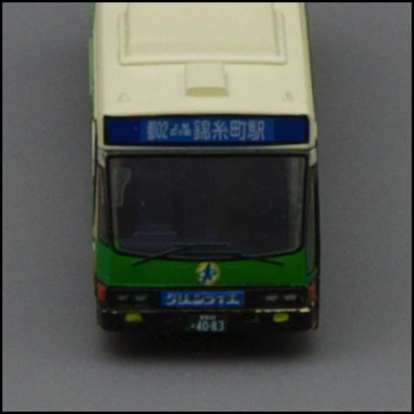
Toei Nissan 96MC - front view
Bus Collection 18 went up for reservation a week ago, and contains five models found in the greater Tōkyō area (of course you may not get one of each in a set of 12). These are Hino Rainbow HR busses, a design introduced in 1999 and still in production. With a pre-release price of about $85 I’ll admit I’m tempted (the price is a bit high if I only get five I want, but not unreasonable).
As regular readers will know, most models built to Japanese N Scale use 1:150 scale, not the 1:160 scale more common to U.S. and European N-scale modeling. The exception are Shinkansen (bullet train) models, which are built to 1:160. Since you aren’t likely to pose a bus immediately next to a Shinkansen, this is unlikely to be an issue. And since most N-scale vehicles and buildings are only approximately to scale anyway, other size problems are likely to be more important. But it’s a detail to be aware of.
Models for Tōkyō (and other Japanese cities)
So when Tomytec introduced their Moving Bus System a few years ago, I was very excited, particularly since the first set available contained a Hino Blue Ribbon Hybrid bus marked for the Tōkyō Metropolitan Bureau of Transportation, more commonly known as Toei, system. This is a bus that uses batteries and regenerative braking along with a smaller diesel motor to conserve fuel. Modern indeed. They have subsequently introduced other sets for an Osaka Hino (set A2), a Meitetsu line Mitsubishi Fuso used in Nagoya, Hiroshima and Fukuoka (B1), a Hiroden Hino used in Hiroshima (B2) and a Nishitetsu Mitsubishi Fuso used in Nagoya, Hiroshima and Fukuoka (B3). And they’ve been pretty good about keeping these in production, although at times they’ll be out of stock.
You can see my Hino Hybrids in action in the YouTube video I did on the Moving Bus System a couple of years ago, there’s a link at the bottom of my Movies page.
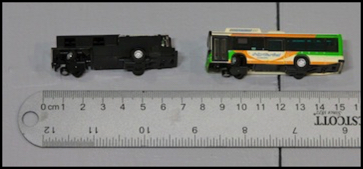
Moving Bus System Motor Unit and Hino Hybrid Bus
But the only way to get those is to buy the entire set, at US$73 for one bus (plus an unpainted shell) that’s a bit pricy when populating a city. I have a couple of these, and will use them to provide some moving busses on my layout (assuming I ever get that part done), but they’re not really a complete solution to my problem of filling the streets with realistic vehicles. A Hybrid is also somewhat special, and a large city needs a number of more normal busses on its streets.
Note: not all Tomytec bus shells are compatible with the motor units sold for the Moving Bus System, and there is more than one type of motor (plus a whole bunch of adapters that come with the motor to make it fit different bodies, which can be hard to puzzle out if you don’t read Japanese). Be sure to check for compatibility if you’re buying buy bodies for motorized use.
Tomytec later introduced the “Bus Collection Toei Bus 2-Car Set A”, which contained both a modern Fuji 7E bus marked for Toei, plus an older (1950s) bus, for US$13, which I think also bears Toei markings, although I’m not familiar with the older ones. Even if you have no use for the second bus, the cost isn’t unreasonable. The 7E used here is a relatively modern design, using compressed natural gas, although Fuji exited the bus market in 2003 (but existing ones will likely remain on the roads for years). This gives me a slightly-different-looking model for my layout. I bought several of these when they first came out.
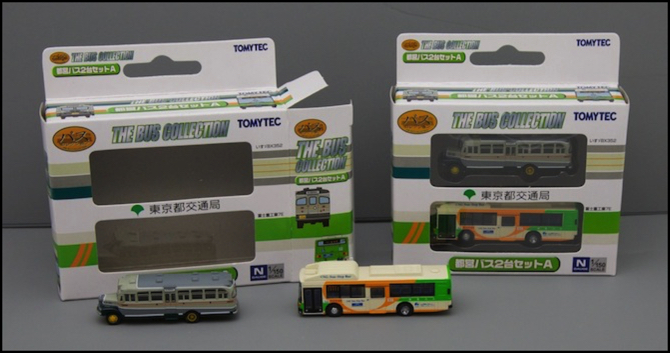
Toei Fuji 7E (right) and an older (1955) Isuzu bus
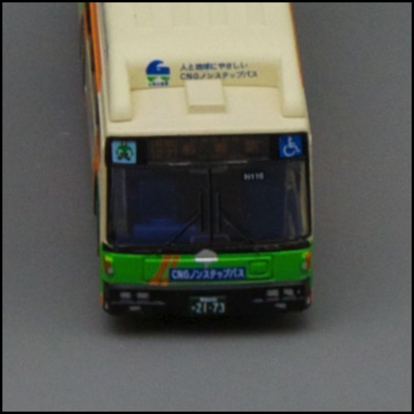
Toei Fuji 7E
They have other two-bus sets, some only with older busses and one with what look like modern tourist busses: a two bus set with JR markings of a Hino and a Fuso, both apparently tour busses serving the Lake Towada resort off Morioka station in Aomori (and thus far from my modeling area), going for US$13. There’s also a two-bus set of Fuji 7E busses with colors, but no lettering, which could be useful if you wanted to letter them for some other location (it’s set “Bus Collection 2-Car Set D Fuji Heavy Industries 7E, New 7E”, for about US$17 for two models, see the Tomytec page in Japanese).
They have also had a couple of five-bus collections, none of which I own, including “The Bus Collection Hino Blue Ribbon II (Non-Step Bus) (5-Car Set) A”, which has Hino busses, one of which was a Tokyu Bus (Tokyu is the other Tōkyō metro-area bus system), but the other four were for the Kansai region. Paying $35 for one bus I could use didn’t appeal, even if it was for the line I didn’t have, so I skipped this one even though I was aware of it.
And there’s “The Bus Collection Nishi-nippon Shatai Kogyo 96MC Non-Step Bus (5-Car Set) A2”, which has one Toei bus and one Kawasaki bus, with the other three from Kyoto, Osaka, and Sasebo (Nagasaki). That one’s more interesting, and I bought a couple of them when they came out.
There were some slightly older collections which could still be reasonable. For example, “The Bus Collection Fuji Heavy Industries 5E (5-Car Set) A”, which contained busses from Yokohama and western Tōkyō, even if they were probably more of a 90’s design. And the “The Bus Collection Hino Blue Ribbon HU&HT (5 Cars Set)” which had three Tōkyō-area busses. Alas I overlooked those at the time, and both sold out long ago.
Other Model Companies
Kato also introduced (last summer) some bus models with two per pack of a Hino Poncho, a small low-floor “microbus” (sets 23-540A and 540B). These sold out quickly and as usual with Kato haven’t yet been re-run (and I missed them at the time). Kato doesn’t describe a specific prototype for these, so I’m not sure what city they are for, or if they’re even supposed to replicate a specific line. The sets run US$15 for two busses, so they’re priced reasonably. Since they’re part of the Diotown line they may eventually be available in the U.S., although I haven’t seen them anywhere yet. I expect to get a few, if only because of the distinctive shape. It usually takes Kato a year or so to re-run something that sells out on introduction, so I’ll keep my eyes open this summer.
Greenmax has also made a few bus models, at about $21 for a set of two, but all appear to be Mitsubishi Fuso Aero Stars, and the most recent came out back in 2010 (and all are sold out). Their Toei bus was sold back in 2001.
A company called DDF has produced a number of bus models over the years, some quite nice if a trifle expensive, but none appear to be more recent than 2006, so they’ve probably gone out of business.
My Latest Model
But the latest from Tomytec is something they’re calling the All Japan Bus Collection. These are single-pack bus models of Mitsubishi Fuso Aero Star busses for about US$9 each, which are compatible with the moving bus motors (they’re sold without the motor, but with an underframe that has rolling wheels). So far set JB001 (Toei), JB002 (Nagoya City Transportation Bureau) and JB003 (Osaka) are available, but in production are additional sets JB004 (Nishi-Nippon Railroad Co. for Nagoya), JB005 (Tokyu for Tōkyō) , and JB006 (Kobe Transportation Authority).
What just arrived this weekend was four of JB001, seen at the top of this post. Clearly I’ll have to also get a number of the Tokyu set as well, as these are the first non-Toei modern busses for the city that I’ve seen.
My JB001 sets (as seen in photo at top) included a sprue of plastic bases and signboards for a pair of bus stops, plus stick-on signs. The bus itself is nicely detailed (although there does seem to be a blemish in the “Non-Step” logo on the driver’s side of one of my busses, as seen below the “S” appears damaged). Pre-applied lettering includes both license plate and destination sign, which is typical of Tomytec’s models.
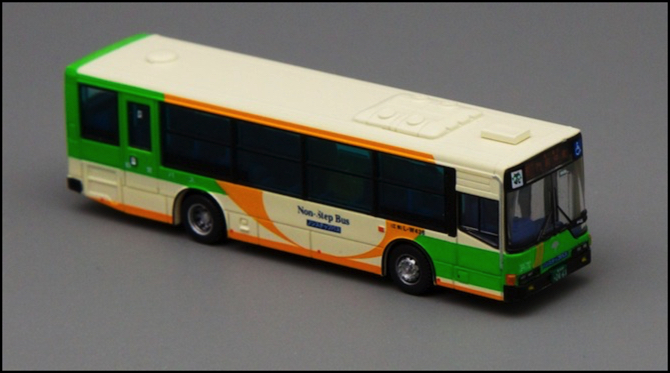
Tomytec model of a Toei Mitsubishi Fuso Aero Star, driver’s side
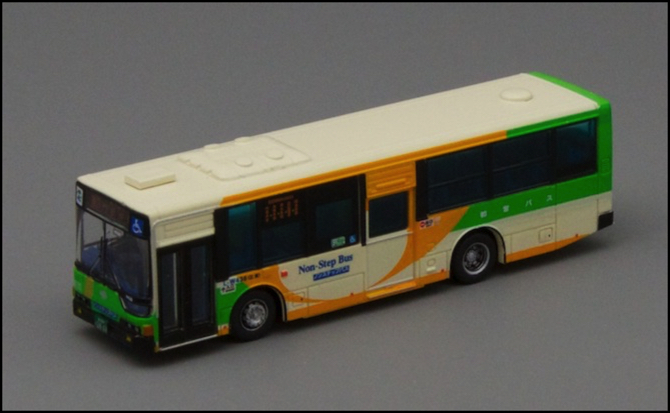
Tomytec model of a Toei Mitsubishi Fuso Aero Star, entry side
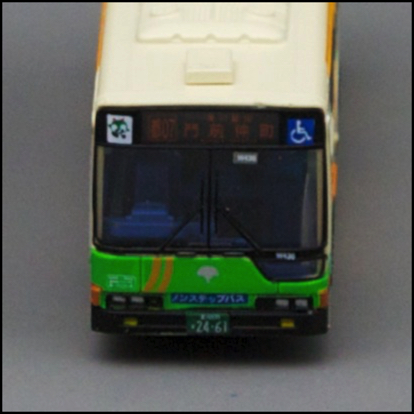
Toei Mitsubishi Fuso Aero Star cab
So thanks to Tomytec, with a small assist from Kato, the modeler of contemporary urban Japanese areas now has plenty of wheeled mass transportation to choose from, for all those little plastic people who don’t live within walking distance of the station.



